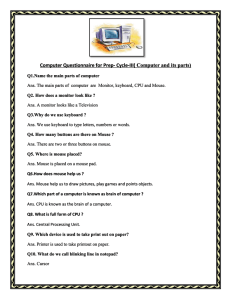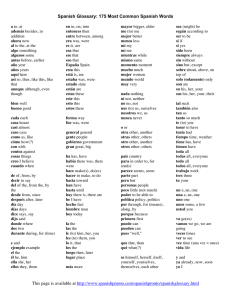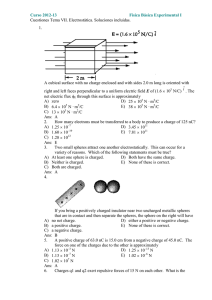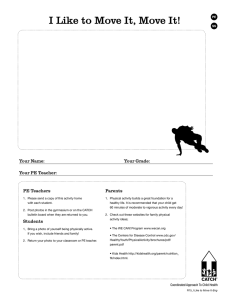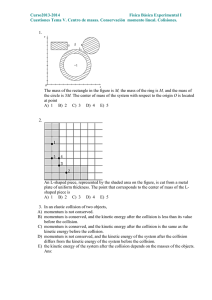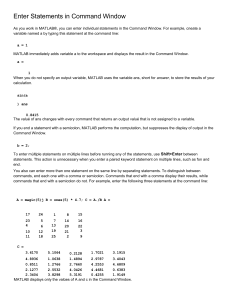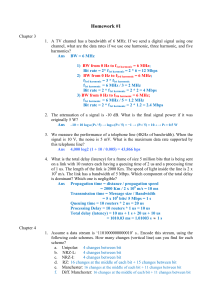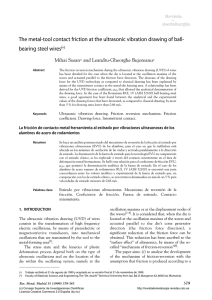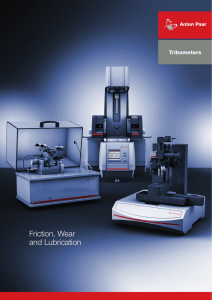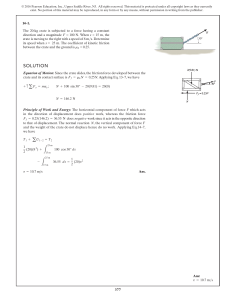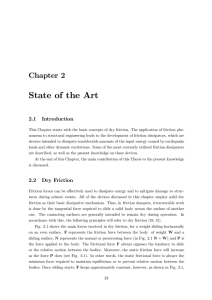Section: 4-1 Topic: Newton`s First Law
Anuncio
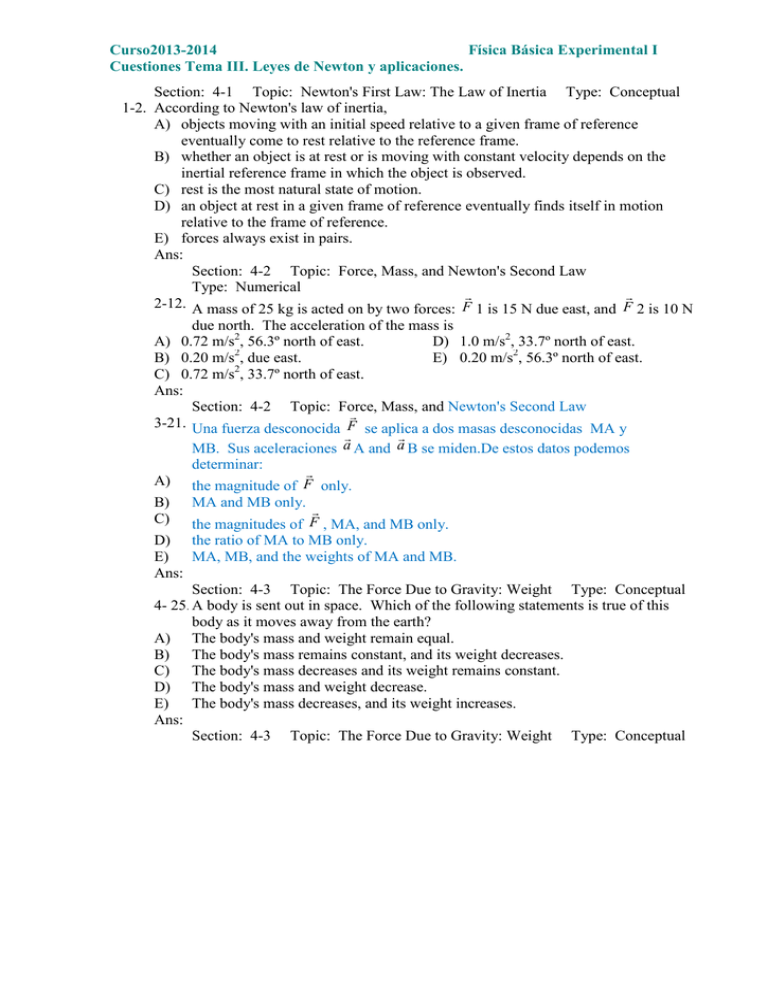
Curso2013-2014 Física Básica Experimental I Cuestiones Tema III. Leyes de Newton y aplicaciones. Section: 4-1 Topic: Newton's First Law: The Law of Inertia Type: Conceptual 1-2. According to Newton's law of inertia, A) objects moving with an initial speed relative to a given frame of reference eventually come to rest relative to the reference frame. B) whether an object is at rest or is moving with constant velocity depends on the inertial reference frame in which the object is observed. C) rest is the most natural state of motion. D) an object at rest in a given frame of reference eventually finds itself in motion relative to the frame of reference. E) forces always exist in pairs. Ans: Section: 4-2 Topic: Force, Mass, and Newton's Second Law Type: Numerical 2-12. A mass of 25 kg is acted on by two forces: F 1 is 15 N due east, and F 2 is 10 N due north. The acceleration of the mass is A) 0.72 m/s2, 56.3º north of east. D) 1.0 m/s2, 33.7º north of east. B) 0.20 m/s2, due east. E) 0.20 m/s2, 56.3º north of east. 2 C) 0.72 m/s , 33.7º north of east. Ans: Section: 4-2 Topic: Force, Mass, and Newton's Second Law 3-21. Una fuerza desconocida F se aplica a dos masas desconocidas MA y MB. Sus aceleraciones a A and a B se miden.De estos datos podemos determinar: A) the magnitude of F only. B) MA and MB only. C) the magnitudes of F , MA, and MB only. D) the ratio of MA to MB only. E) MA, MB, and the weights of MA and MB. Ans: Section: 4-3 Topic: The Force Due to Gravity: Weight Type: Conceptual 4- 25. A body is sent out in space. Which of the following statements is true of this body as it moves away from the earth? A) The body's mass and weight remain equal. B) The body's mass remains constant, and its weight decreases. C) The body's mass decreases and its weight remains constant. D) The body's mass and weight decrease. E) The body's mass decreases, and its weight increases. Ans: Section: 4-3 Topic: The Force Due to Gravity: Weight Type: Conceptual Curso2013-2014 Física Básica Experimental I Cuestiones Tema III. Leyes de Newton y aplicaciones. 5-37. The system in the figure consists of a steel ball attached by a cord to a large block of wood. If the system is dropped in a vacuum, the force in the cord is A) B) C) D) E) Ans: zero. equal to the difference of the masses of B and W. equal to the difference of the weights of B and W. equal to the weight of B. equal to the sum of the weights of B and W. Section: 4-4 Topic: Newton's Third Law Type: Conceptual 6-41. An 80-kg man on ice skates pushes a 40-kg boy, also on skates, with a force of 100 N. The force exerted by the boy on the man is A) 200 N D) 40 N B) 100 N E) zero unless the boy pushes back. C) 50 N Ans: Section: 4-5 Topic: Forces in Nature Type: Numerical 7-52. Spiral springs A and B are identical. When a weight of 12 N is fastened to the hook on A, the hook is lowered 2 cm. If a weight of 18 N is fastened to the hook on B, that hook is lowered A) 8 cm B) 6 cm C) 3 cm D) 4 cm E) 5 cm Ans: Section: 4-6 Topic: Problem Solving Type: Conceptual 8-55. Which of the following free-body diagrams represents the car going uphill at a constant speed? A) 1 B) 2 C) 3 D) 4 E) 5 Curso2013-2014 Física Básica Experimental I Cuestiones Tema III. Leyes de Newton y aplicaciones. Ans: C Section: 5-1 Topic: Friction Type: Numerical 9-1. A 100-kg block is pushed up a 30º incline that is 10 m long. If the coefficient of friction between the block and the incline is 0.1, the constant force parallel to the incline that is required to move the block from rest at the bottom of the incline to the top in 3 s is approximately A) 0.49 kN B) 0.085 kN C) 0.22 kN D) 0.80 kN E) 0.58 kN Ans: Section: 5-1 Topic: Friction Type: Conceptual 10-5. Four identical blocks are moving on a surface for which the coefficient of kinetic friction between each block and the surface is µk. The velocity of each block is indicated by the vector on the block. For which block is the force of friction between the surface and the block greatest? A) 1 B) 2 C) 3 D) 4 E) The force of friction is the same for all blocks. Ans: Section: 5-1 Topic: Friction Type: Conceptual 11-8. Two objects are sliding at the same speed across a wooden surface. The coefficient of kinetic friction between the first object and the surface is twice that between the second object and the surface. The distance traveled by the first object before it stops is S. The distance traveled by the second object is A) impossible to determine without knowing the masses involved. B) 2S C) S/2 D) S E) 4S Ans: Section: 5-1 Topic: Friction Type: Conceptual 12-15 Un bloque de masa m se empuja en la dirección que muestra la figura sobre una superficie rugosa a velocidad constante. La magnitud de la fuerza de fricción es A) µkmg B) µkT cos θ C) µk(T – mg) D) µkT sen θ E) µk(mg – T sen θ) Ans: Section: 5-1 Topic: Friction Type: Conceptual 13-26 A) B) C) D) The system in the figure is moving with constant speed v to the right on a stationary ramp. The system will accelerate to the right if angle α is increased. angle β is increased. the coefficient of friction µk for surface A is increased. the coefficient of friction µk for surface B is increased. Curso2013-2014 Física Básica Experimental I Cuestiones Tema III. Leyes de Newton y aplicaciones. E) the normal force on block 2 is increased. Ans: Section: 5-1 Status: New to 5th edition 14-32 Topic: Friction Type: Numerical A 2-kg block sits on an incline where the top part of the incline has a coeffficient of kinetic friction (µk) of 0.70. The bottom section of the plane has µk = 0.95. The angle of inclination is 40 degrees. The block is released and travels 10 m along the initial part of the incline and then enters the lower section. Calculate how far the block travels along the second section before it is brought to a stop. A) 2.7 m B) 21 m C) 23 m D) 13 m E) 260 m Ans: Section: 5-2 Topic: Circular Motion Type: Conceptual 15-39 A car going around a curve of radius R at a speed V experiences a centripetal acceleration ac. What is its acceleration if it goes around a curve of radius 3R at a speed of 2V? A) (2/3)ac B) (4/3)ac C) (2/9)ac D) (9/2)ac E) (3/2)ac Ans: Section: 5-2 Topic: Circular Motion Type: Conceptual 16-42 A car experiences both a centripetal and a tangential acceleration. For which of the following would this be true? A) It is going around a curve at a constant speed. B) It is going around a curve and slowing down. C) It is going along a straight road at a constant speed. D) It is going along a straight road and increasing its speed. E) It is going along a straight road and decreasing its speed. Ans: Section: 5-3 Topic: Drag Forces Type: Conceptual 17-49 The net force acting on an object is zero. You can therefore definitely conclude that the object is A) at rest. B) moving in a straight line at constant speed. C) moving in a circle at constant speed. D) undergoing acceleration. E) either at rest or moving in a straight line at constant speed. Ans: Respuestas (por orden): B C D B A B C C D E B E B D B B E Curso2013-2014 Física Básica Experimental I Cuestiones Tema III. Leyes de Newton y aplicaciones. 18 Un cubo en el seno de un líquido se encuentra en equilibrio cuando está sumergido una profundidad h. Se le da un pequeño empujón hacia abajo y se pide describir el movimiento subsiguiente. Bauer, 14.27 pg 487 THINK: If the cube is pushed into the liquid, it will feel the force of buoyancy acting against it. This will set the block in an oscillatory motion. The density of the liquid is given as ρ l . equilibrio: The mass of the liquid displaced by the block is = ml ρ= Vl ρ l l 2 h , l The force of buoyancy Fb = ml g. is equal to the force of gravity on the displaced liquid, Fg=mcg The mass of the displaced liquid is equal to the mass of the cube, ρ l 2h ρ h mc = ρcVc = ρcl 3 =ml = ρ l Vl = ρ l l 2h ⇒ ρc = l 3 = l . l l Después de un pequeño empujón hacia abajo (aceleración hacia arriba) The forces on the cube give the following equation of motion: Fb+∆ Fb −Fg=−mc a Es decir, ∆ Fb =mc a where mc is the mass of the cube. Taking into account the density of the cube and the liquid: ρll2xg=−ρcl3a es decir, a =−(ρl /ρc )xg/l que tiene la forma a=−ω2x The frequency of the oscillation is then ω = k = m ρl l 2 g = ρ cl 3 ρl g . ρ cl SIMPLIFY: The frequency of the oscillatory motion of the cube is: 1 1 ρl g 1 ρl g 1 f ω = = = = 2π 2π ρcl 2π ρ l h 2π l l Section: 14-1 Topic: Simple Harmonic Motion g . h Type: Numerical 19-2 A ball moves with simple harmonic motion between points A and B. The magnitude of the acceleration of the ball at point C is 5.00 m/s2. The magnitude of the acceleration of the ball at point D is A) 1.25 m/s2 B) 2.50 m/s2 C) 5.00 m/s2 D) 7.50 m/s2 E) 10.0 m/s2 Ans: E Curso2013-2014 Física Básica Experimental I Cuestiones Tema III. Leyes de Newton y aplicaciones. 20-6. Se suelta una masa m atada al extremo de una cuerda desde el reposo en el punto A. Cuando pasa por el punto más bajo B, la tensión de la cuerda es A) Imposible de determinar; la respuesta depende de la longitud de la cuerda. B) mg C) 2mg D) 3mg E) Ninguna de las anteriores es correcta. Ans: C 21-4. Una masa 2m está atada por una cuerda a otra masa m como se muestra en la figura. Una N fuerza actúa sobre la masa m para acelerar el sistema. La fuerza F que actúa sobre la masa 2m, es A) (2/3)N B) N C) 2N D) 3N E) (3/2)N 22-4. Los dos bloques de la figura adjunta tienen masas M1 y M2 siendo M1 < M2 y descansan sobre una superficie horizontal sin fricción. Podemos aplicar una fuerza F horizontal por la derecha o por la izquierda, como muestra la figura. La fuerza de y M2 es contacto entre las masas M1 F A. la misma en ambos casos. B. mayor cuando F se aplica por la izquierda. C. mayor cuando F se aplica por la derecha. D. cero newtons (N). E. imposible de determinar con estos datos. 23-5. Considera dos libros de texto, uno de ellos reposa encima del otro. El libro de abajo tiene una masa y está reposando sobre una superficie prácticamente sin rozamiento. El libro de arriba tiene una masa , con < . Supón que el coeficiente de fricción estática entre los libros es . Curso2013-2014 Física Básica Experimental I Cuestiones Tema III. Leyes de Newton y aplicaciones. Considera los siguientes dos experimentos: Empujas el libro superior horizontalmente con la máxima fuerza de tal forma que los dos libros se mueven juntos sin deslizarse.(Fig. izquierda) Empujas el libro inferior horizontalmente con la máxima fuerza de tal forma que los dos libros se mueven juntos sin deslizarse.(Fig. derecha) ¿Qué fuerza es mayor en magnitud? Demuéstralo
